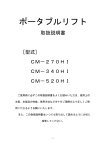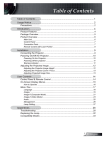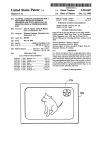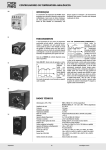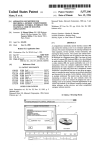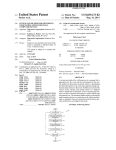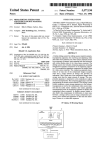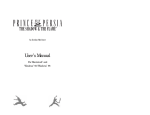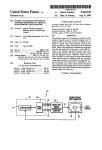Download l|l|llllllllllllllllllll|||l|lllllllllllllllllllllll
Transcript
Illlllllllllll|||ll||||l|l|llllllllllllllllllll|||l|lllllllllllllllllllllll USO05528316A United States Patent [19] [11] Patent Number: Lee [45] [54] METHOD FOR SELECTING A TELEVISION TURN-ON TIME VOLUME LEVEL [75] Inventor: Date of Patent: San S_ Lee’ Suwon, Rep of Korea OTHER PUBLICATIONS Kyungki-Do, Rep. of Korea JVC Service Manual 27" Color Monitor Receiver l991/Jul. JVC Instructions AV-2781S color Monitor Receiver Jul./ [21] Appl. No.: 202,581 [30] 1991 Miyoshi “Television Receiver”, 1 an./ 1992. Feb. 28, 1994 Primary Examiner—]ames J. Groody Assistant Examiner-N. N. West Foreign Application Priority Data Feb. 26, 1993 [KR] Jun. 18, 1996 4,843,384 6/1989 Ide et a1. 340/825.69 4,963,994 10/1990 Levine 358/335 4,977,455 12/1990 Young 358/142 5,191,231 3/1993 Berry .................................... .. 348/730 [73] Assignee: Samsung Electronics Co., Ltd., [22] Filed: 5,528,316 Rep. of Korea ...................... .. 93-2756 éég’smey’ Agent’ 0' F'""_S“ghme’ M10“, Zmn’ Macpeaks‘ [51] [52] Int. GL6 ..................................................... .. H04N 5/60 US. Cl. ........................................... .. 348/725; 348/738 [57] [58] Field of Search ................................... .. 348/730, 734, The television sound volume to be achieved when a televi 348/738, 569, 729, 725, 6; H04N 5/63, 7/10, 5/44, 5/60, 5/46, 5/76 [56] References Cited viewing an on-time reservation means on the television Screen‘ 2/1987 Beyers, Jr. ........................... .. 360/331 10 Claims, 2 Drawing Sheets 40o BUS mm P c PLL DATA OUTPUT m SPEC 10o \ ~41 "2 TUNER AFC INPUT \ ROM P' TL KEY PAD CHARACTER ROM 70o 43 INTERMEDIATE / FREQ. [C OSD GENER CKT- 30o 8 Am 1‘ REMO'1‘E—~ comm. RECEIVER s’ '11 '1 VIDEQ 1C 200 armors/J .a_ T ¢—— AUDIO IC 1 801 R 1 900 R G B Y e02 803 CR AUDIO SIGNAL vmro SIGNAL 1 // 0011111 ’ sion is turned on by an on-time reservation function is preset into the system along with presetting the on-time of the television. The setting is accomplished using arrow keys and U.s. PATENT DOCUMENTS 4,641,205 ABSTRACT RGB G R G B DRIVER B “Tm Y 10 800 VIDEO SIGNAL R A“? vmro SIGNAl. G L 901 VIDEO SIGNAL 8 R US. Patent Jun. 18, 1996 Sheet 2 0f 2 5,528,316 FIG . 2' _ _ _ - +13 ‘_43/ v—O/O—~ gm g2‘? $123 524 g“ ‘ K ‘ 0/ 0 0/ Pong-L cmnongl cumnon?l vol-W271 ‘mm ‘ D>1|_ LOIUT_1 ' LIN_1 K_[N__2 [LINJS w LII‘LA v LIN_5 ' FIG. 3 — TV/VIDEO POWER . - 4 5 6 may 7 a 9 ggPxgg CHANNEL‘ 0 ERASE MEMORY MODE ; MODE .- INDEX MODE + MODE + CS§§TE§& 52mm CHANNEL? @E‘fi‘g?gf HELP w?EING 1' .Fr‘tl?mm SEéiiE-é?” S‘é‘HPNA6‘D CAPTION §é&%%%‘§ 5,528,316 1 2 METHOD FOR SELECTING A TELEVISION TURN-ON TIIHE VOLUME LEVEL power-on of a television, thereby satisfactorily performing an alarm function. Also, when the power of the television is turned on by the on-time reservation function, the desired volume is produced to be convenient to a user. BACKGROUND OF THE INVENTION To achieve the above object of the present invention, a volume programming method for a television having an 1. Field Of The Invention The present invention relates to an on-time reservation (a programming of tum-on time of a television) function in a television, and more particularly to a volume programming method included in an on-time reservation function, wherein on-time reservation function comprises the steps of: setting current time, turn-on time and tum-oh" time of the television, and volume by means of arrow keys when a menu screen is IO volume is programmed together with reservation of the comparing current time with the programmed tum~on time turn-on time of a television to produce a desired volume level at the time of power-on of the television. to check whether or not they are coincident with each other; determining whether the television is already turned on when the current time coincides with the turn-on time of the Korean Patent Application No. 93-2756 is incorporated herein by reference for all purposes. 2. Description Of The Prior Art Typically, by programming the turn-on time of a televi television; and ignoring the on-time reservation function when the television is already turned on, or turning on the power of the television, selecting a channel corresponding to the channel viewed at the time the television was last turned sion in accordance with an on-time reservation, the power to the television is turned on when a current time coincides with the programmed turn-on time. The television stores the volume level existing at the time it is turned off, and when it is later turned on, the volume off, and producing the programmed volume. 20 BRIEF DESCRIPTION OF THE DRAWINGS The above objects and other advantages of the present level will be set at that which was stored at the time of the power-o? state. invention will become more apparent by reference to the 25 following description of detail preferred embodiments thereof with reference to the attached drawings in which: FIG. 1 is a block diagram schematically showing a circuit for programming a volume level in an on-time reservation An on-time reservation function is useful as a morning wake-up alarm, but the sound volume of the television may be too low to perform satisfactorily, the alarm function since the television may have last been watched during very late nighttime hours with the volume turned way down. displayed by pressing a key for the on-time reservation; 30 Accordingly, in order to secure a desired volume at the function according to the present invention; FIG. 2 shows the construction of the key pad shown generally in FIG. 1; time of automatic tumnon of the television by the on~time FIG. 3 shows the construction of the remote controller reservation function, the television must be set to have a shown generally in FIG. 1; desired sound volume prior to being turned o?. This is a FIGS. 4A-4F show one embodiment of a volume pro problem because the viewer may forget to increase the sound 35 gramming sequence according to the present invention; and before turning off the set at night, and, even if the viewer FIG. 5 is a ?ow chart of the volume programming method remembers to increase the volume late at night, the increased in the on-time reservation function according to the present sound volume may disturb others. invention. Japanese Patent Laid-Open No. Hei. 4-51683, entitled ‘”Timer—Setting method of a television receiver,” describes a technique in which current time, time of a program timer and alphanumeric screen information for setting the tum-onl-oif time of a timer are simultaneously displayed by an on-screen display (OSD) circuit on a cathode ray tube (CRT), and the respective times are set using the OSD circuit. That is, the DETAILED DESCRIPTION OF THE PREFERRED EMBODIMENTS screen of the television receiver is set to a timer-setting Referring to FIG. 1, there is shown a circuit for executing volume programming with an on-time reservation function, where a key pad 100 incorporated on the television and a remote controller 200 have keys for performing time setting screen mode in which the alphanumeric information for setting the current time and the time of the timer is displayed and volume level programming in connection with an on time reservation function, and a remote-control receiver 300 using the OSD circuit in conjunction with the manipulation for receiving key input signals from the remote controller of a program key. At the same time, a time-setting mode of the timer for setting the time of the timer is primarily set when the current time is preset during manipulation of the program key, or a current time-setting mode for setting the current time is primarily set when the current time is not set 200. Additionally, a microcomputer 400 controls the overall system in accordance with a key signal from the key pad 100 during manipulation of the program key. Therefore, the or the remote~control receiver 300. A tuner‘600 operates 55 index of setting the timers is displayed on a single screen to signal from the microcomputer 400 and to convert the selected RF signal (channel) into an intermediate frequency easily understand mutual time relationship of various timers, but the desired volume cannot be heard during power-on of signal. the television by the on-time reserving function. 60 SUMMARY OF THE INVENTION conventionally to select a radio frequency (RF) signal in accordance with a phase-locked loop (PLL) data output ‘ An intermediate frequency IC 700 ampli?es the interme diate frequency signal from the tuner 600 and separates the signal into a video signal and an audio signal which are output therefrom. Circuit 700 also outputs an automatic The present invention is designed to solve the above frequency control signal to the microcomputer 400. The described problems. Accordingly, it is an object of the present invention to provide a volume programming method 65 AFC signal automatically lowers the horizontal oscillating for programming the volume during an on-time reservation frequency of an oscillator (not shown) when the oscillating frequency thereof becomes higher than a horizontal syn function to produce the programmed volume at the time of 5,528,316 3 4 chronizing signal from a transmitting side, or automatically raises the horizontal oscillating frequency when the latter is one example of the display of the volume level on CRT 803 using the OSD generating circuit 43 during the power-on of lower than the horizontal synchronizing signal, thereby constantly and accurately performing horizontal synchroni the television or as a result of an input of a volume up/down zation. A video IC 800 receives the video signal from the intermediate frequency IC 700 and video control signals P’TL from the microcomputer 400 to separate them into RGB signals. An audio IC 900 receives the audio signals from the intermediate frequency IC 700 and audio control 10 signals S’TL from the microcomputer 400 for amplifying . them in an ampli?er 901, and the result of the ampli?cation is externally output via speakers SP. Here, the video control signals P’TL control the contrast, brightness, color, tint, sharpness, etc., and the audio control signals S’TL control the volume, bass, treble, balance, etc., all of which is well known in the television art. Themicrocomputer 400 has a RAM for temporarily storing data, a spec 41 for storing a feedback address when the microcomputer 400 processes subroutines, a ROM for storing'a program executed by the microcomputer 400, and FIG. 5 is a ?ow chart of the method for performing volume level programming as part of the on-time reservation function according to the present invention. In step 501, the current time, turn-onl-oif time of the television, and volume I‘ at turn-on time are set by means of the key pad 100 or the compares the current time with the tum-on time and deter: mines whether or not they are the same. If they are not the same, the program ends. If they are the same, then in step 503 the microcomputer determines whether the timer is on or not. If the timer is not on, the program ends. If the timer is on in step 504, the microcomputer determines whether or 20 not the television is turned on. If the television is turned on, the on-time reservation is ignored and the program ends. If ~ ‘ the television is off in step 505, the power of the television is turned on, the volume selected is that set in step 501, the ‘ volume control status on a screen, e.g., CRT 803, of the channel selected is the last channel viewed at the time of 25 power-01f the television, the channel number is displayed on the CRT 803 using the OSD generating circuit 43, and the 3 LED in circuit 500 is caused to ?icker for a predetermined ‘ brief period of time and be turned on thereafter. According to the present invention as above, the key pad 100 on the television and the remote controller 200 advan tageously can be used for the time setting and volume level setting for the on-time reservation function. The signal from the remote controller 200 is supplied to the microcomputer the information stored on the RAM, and a program counter stores an address of a command in the memory to be executed later and sequentially reads out the stored com~ mand from the memory While increasing the address in the key pad 100 or on the remote control device 200. 1 remote controller 200. At step 502, the microcomputer a character ROM 42 for storing character font data for displaying characters such as a selected channel number and television. Moreover, an on-screen display (OSD) generat ing circuit 43 reads out the character font data to be displayed on the television from the character ROM 42 and separates the read out data into color signals R,G and B and a lumina signal Y and outputs the separated signals. An arithmetic. logic unit carries out operations in accordance with the command of the microcomputer 400 by reading out key on one of the key pad 100 or on the remote control‘ device 200. All entries, such as current time, turn-on time, etc., are made by pressing the appropriate number or arrow keys on 35 increments of one. 400 through the remote~control receiver 300. ' The tuner 600 operates in a conventional manner in response to the PLL data from the microcomputer 400 to select the appropriate channel and to convert the selected RF channel frequency into an intermediate frequency, thereby supplying the intermediate frequency to the intermediate Furthermore, an RGB matrix 1C 801 mixes and outputs the color signals RGB and lumina signals Y from the video IC 800 and the OSD generating circuit 43 from the micro computer 400, and an RGB driver 802 receives the color frequency IC 700. The intermediate frequency IC 700 then ampli?es the intermediate frequency from the tuner 600, separates, the ampli?ed intermediate frequency into the video signal and signals R, G and B and the lumina signals Y from the RGB ' matrix IC 801and applies them to a conventional CRT 803 television screen. the audio signal to supply the video signal to the video IC Also, the microcomputer 400 is connected to a display circuit 500 which is formed of a transistor Q1 having a base connected to the microcomputer 400, and a light-emitting diode (LED) connected between an emitter of the transistor 800 and the audio signal to the audio IC 900. ‘ Also, the intermediate frequency IC 700 supplies the AFC 5/ signal to the microcomputer 400 for automatically lowering , the horizontal oscillating frequency when the oscillating . Q1 and a power supply voltage +B. FIG. 2 shows one embodiment of the construction of the 50 frequency from the horizontal oscillating circuit becomes higher than the horizontal sync signal from the transmitting key pad 100 in FIG. 1, and FIG. 3 shows one embodiment of the construction of the remote controller 200 in FIG. 1, side, or automatically raises the horizontal oscillating fre quency to allow the horizontal synchronization to be con wherein the on-time reservation can be executed by means stantly performed. of a selected key, e. g., an index key or an arrow key. The video IC 800 separates RGB signals from the video FIGS. 4A-4B show the screen status of the television in 55 signal supplied to its input side to supply them. to the RGB one embodiment of the on-time reservation and volume matrix IC 801, and the audio IC 900 ampli?es the audio 8 level programming process when the index signal is input through the key pad 100 or the remote controller 200. FIG. 4A shows a menu screen displayed: as a result of the index signal generated by one of the key pad 100 or remote 60 controller 200, and FIG. 4B shows one example of the control signal P’TL to the video IC 800 to control the contrast, brightness, color, tint, sharpness, etc., and outputs setting of current time on the menu screen of FIG. 4A. the audio control signal S’TL to the audio IC 900 to control the volume, bass, treble, balance, etc., all in a conventional FIG. 4C shows an example of the setting of the tum-on time of the television on the menu screen. FIG. 4D shows one example of the setting of the volume level to be achieved at tum-on time. FIG. 4B shows one example of the setting of the turn-o?' time for the television. FIG. 4F shows signal supplied to its input side in the ampli?er 901‘ and 1‘, externally supplies the ampli?ed signal via the speakers SP. , At this time, the microcomputer 400 supplies the video 65 manner. Meanwhile, if the RGB color signals and lumina signal Y, representing character data from OSD generating circuit 43 5,528,316 5 6 of microcomputer 400, are supplied to the RGB matrix IC 801, they are mixed with the RGB signals from the video IC 800 to display the result of the mixing on the cathode ray tube display screen 803 via the RGB driver 802. The microcomputer 400 supplies a low signal to the base I claim: 1. A method of selecting a sound volume level at a tum-on time, in a television system having an on-time reservation function, a key entry device with arrow keys, and an on~time menu displayed on a screen of the television, said method of the transistor in circuit 500 to turn on the LED when the timer is turned on, or supplies a high signal to turn o? the LED when the timer is turned off. If the television power is turned on by on-time reservation function, the transistor Q1 is turned on and off in 0.5 second intervals for a predeter~ comprising the steps of: setting current time, tum-on time and turn-off time of said television and volume level by means of arrow keys when said on-time menu screen is displayed by a user pressing a key for said on-time reservation, wherein said volume level corresponds to the television volume mined period, e.g., 10 seconds, under the control of the microcomputer 400, thereby causing the LED to ?icker. The volume level programming process by on-time will be described in detail with reference to FIGS. 4 and 5. To initiate on-time programming, the operator presses the at the turn-on time; comparing current time with said set tum-on time of said 15 cident with each other; determining whether or not said television is already appropriate key, e.g., index key of the key pad 100 or the remote controller 200, thereby causing a display of the menu screen as shown in FIG. 4A. Using the arrow keys ——>, <—, T, i, the current time is set as shown in FIG. 4B, and the 20 ' turn-on time of the television is programmed as shown in FIG. 4C. As shown in FIG. 4D, the volume level to be achieved at the time of turning on the television is keyed in. At this time, the programmed volume level may be the same as the main on the power of said television, automatically selecting the last channel viewed at the time the television was 25 tumed-on when the step of automatically turning on the power of said television takes place. 3. A method of selecting a sound volume level at a tum'on time, in a television system having an on-time reservation function, a key entry device with arrow keys, and an on-time menu displayed on a screen of the television, said method the key for actuating the on-time function is activated, the microcomputer 400 supplies a low level signal to the tran 35 sistor Q1 of the display circuit 500 to turn on the LED. Thereafter, the current time is compared with the tum-on time that was set at step 501 to determine if the times are coincident. Steps 502-505 proceed as previously described. 40 (a) setting current time, turn~on time and turn-01f time of said television and volume level of the television at turn-on time; (b) comparing current time with said set turn-on time of said television to determine whether or not they are time determining whether or not said television is is displayed on the screen by means of the OSD function, vation function and the television is turned on by on-time function, the volume maintains the programmed volume until one of volume up/down key is manipulated to adjust the volume. Moreover, the microcomputer 400 stores the last channel at the time of power-o?' of the television to select the corresponding channel, displays the channel number on the screen using the OSD generating circuit 43, function, and ?ashes the LED for approximately 10 seconds at on/o?C intervals of 0.5 seconds. According to the volume programming method as described above, the volume can be programmed together with programming the turn-on time of the television. While the present invention has been particularly shown and described with reference to particular embodiments thereof, it will be understood by those skilled in the art that various changes in form and details may be effected therein without departing from the spirit and scope of the invention as de?ned by the appended claims. comprising the steps of: coincident with each other; (e) when said current time is coincident with said turn-on the control of the microcomputer 400, the volume is pro vided at the programmed volume level, and the volume level i.e., using OSD generating circuit 43, as shown in FIG. 4F. Here, the volume level is identical to the main volume level. Once the volume is determined by the on-time reser last turned off and automatically adjusting the sound volume to the set volume level. 2. The method of claim 1, further comprising the step of providing an indication that the television was automatically if the volume level is not programmed, the volume level upon power-on of the television by the on-time reservation function becomes the default value. After programming the turn-off time of the television as shown in FIG. 4E, the on-time function is activated. When If the television is determined to be oif in step 504, step turned on when said current time is coincident with said tum-on time of said television; and if said television is determined in the preceding step to not having been already turned on, automatically turning volume level. For the convenience of the user, a default value of the volume is set at a ?xed level, e.g., 30/100. Thus, 505 is carried out to turn on the power of the television under television to determine whether or not they are coin 45 already turned on; and (d) when said television is off in said step (c), automati cally turning on the power of said television, automati cally selecting the last channel viewed at the time the television was last turned 01? and automatically adjust ing the sound volume to the set volume level. 50 55 4. The method of claim 3, further comprising the step of providing an indication that the television is automatically tumed-on when said step (d) is initiated. 5. The method of claim 2, wherein said indication is a ?ickering indication for a predetermined amount of time. 6. The method of claim 5, wherein an LED provides said ?ickering indication. 7. The method of claim 4, wherein said indication is a ?ickering indication for a predetermined amount of time. 8. The method of claim 7, wherein an LED provides said 60 ?ickering indication. 9. The method of claim 1, wherein said the volume level is set to an arbitrary level by the user via the arrow keys. 10. The method of claim 3, wherein said the volume level is set to an arbitrary level by a user. 65 * * * * *







